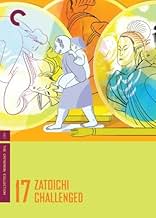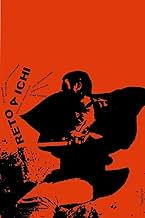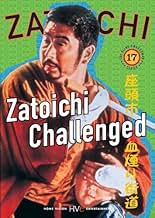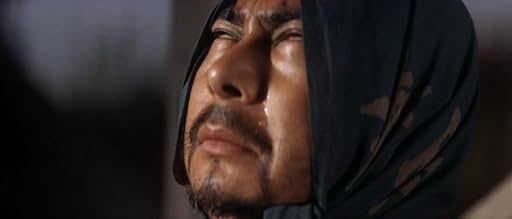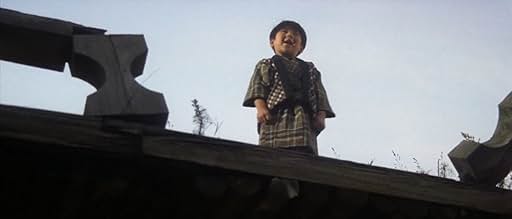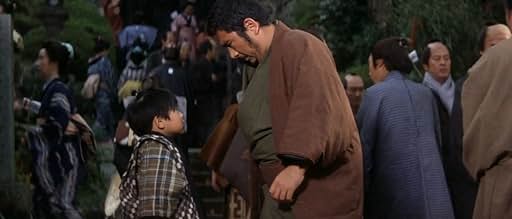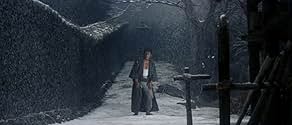La Légende de Zatoïchi : Route sanglante
Titre original : Zatôichi chikemuri kaidô
NOTE IMDb
7,4/10
1,6 k
MA NOTE
Ajouter une intrigue dans votre langueAfter an artist is threatened by the yakuza into creating valuable but highly illegal pornography, the law aims to execute him. Zatoichi, having been honor bound to protect the man and his f... Tout lireAfter an artist is threatened by the yakuza into creating valuable but highly illegal pornography, the law aims to execute him. Zatoichi, having been honor bound to protect the man and his family, must now run against the law.After an artist is threatened by the yakuza into creating valuable but highly illegal pornography, the law aims to execute him. Zatoichi, having been honor bound to protect the man and his family, must now run against the law.
- Réalisation
- Scénario
- Casting principal
Osami Nabe
- Dice Player Hanzo
- (as Osamu Nabei)
Akihisa Toda
- Shinnosuke Emi
- (as Hirohisa Toda)
Avis à la une
I love Japanese movies, they are totally different from all the other movies in the rest of the world. I grew up with Akira Kurosawa and his films, plus a few other masterpieces by Kaneto Shindo, Hiroshi Teshigahara, Nagisa Oshima, and more. This Zatoichi is the first in this series that I see. I didn't expect it to be so good, I imagined I would see a light comedy with some samurai. In fact, it's a complex movie, it's a samurai movie and their honor, it's also a comedy, and it's a drama too. Exceptional actors, masterful direction, simple and captivating story, beautiful music, in short, a very good film which absolutely worth seeing.
The director Kenji Misumi was a prolific film maker from the Rising Sun Empire, and specialized in mostly Samourai features. This kind of movie is always the same, more or less same schemes provider, blood sword battles, honor, friendship, loyalty, sorrow, some humor from time to time. All those elements together, melted, giving something typical from Japanese movies plots, all genres confounded, even yakuzas or even horror films. Plots are always a bit complex to follow, especially from Western Europe audiences, nothing to do with Hollywood spirit for instance. This ZATOICHI series could be compared with BABY CART movies; same kind of lead errant character, fighting all kinds of enemies. If you are a samourai films lover, this movie will enchant you, if not, just watch it and then you'll have an idea of what it is. If you are reluctant to those films, get away from it. But this one is rather enjoyabe and not too long. My "trick" to appreciate all those all alike films and schemes if to find and then analyze the "villain" of the story, the one our lead hero will have to fight against in the end. For me the villain is the most fascinating element in those stories, never the lead.
10user54
Shintaro Katsu's Zatoichi is such a memorable character not only because of his talent with a sword, but because he acts justly in an unjust world, even as a member of the yakuza "gangster" caste, an outcast of normal society, a nobody in status compared to a samurai; often, in fact, labeled a criminal. No one respects him for his honor, but only for his ability to kill. The world around him is based on fear, corruption and evil, and even the people that are good are invariably weak in the face of the strong and corrupt.
This Zatoichi story is unique. The blind swordsman is at a traveler's inn with a woman and her child when the woman dies. Her dying request is that Ichi take the boy to his father. Unfortunately the father is trapped in a plot to produce forbidden images on pottery and plates -- artistic renditions of women that are often hardly even suggestive, but in those days were outlawed. It is over pottery designs that much violence is to occur thanks to corrupt officials, evil yakuza, and the twisted justice of the government.
Zatoichi has often been juxtaposed with a costar acting as a foil. In ZATOICHI CHALLENGED that foil is a child on the road with Ichi. This pairing elicits just the right combination of emotion and personality from the blind swordsman, giving his character added depth and feel. It is very gratifying to see Zatoichi in a fatherly role.
Ichi deserves more empathy and respect in this film. The father-son story device, the twisted justice of the government samurai, and the stylistic energy of the film are the perfect background for what Ichi's character symbolizes. Here Ichi is complete; an excellent protagonist.
The final battle scene takes uncommon form -- the added effect of the snow alone makes it magical. It is more stylistically shot than most Zatoichi battles, it seems edited with emphasis on emotion rather than action, and it ends in a very atypical way. Here the action seems to be balanced well in benefit of the story and style of the film. This makes the action for its own sake all the more beautiful to watch.
Also see the father-son device used in another excellent samurai series, Lone Wolf and Cub (Kozure Okami), starring Shintaro Katsu's brother, Tomisaburo Wakayama.
This Zatoichi story is unique. The blind swordsman is at a traveler's inn with a woman and her child when the woman dies. Her dying request is that Ichi take the boy to his father. Unfortunately the father is trapped in a plot to produce forbidden images on pottery and plates -- artistic renditions of women that are often hardly even suggestive, but in those days were outlawed. It is over pottery designs that much violence is to occur thanks to corrupt officials, evil yakuza, and the twisted justice of the government.
Zatoichi has often been juxtaposed with a costar acting as a foil. In ZATOICHI CHALLENGED that foil is a child on the road with Ichi. This pairing elicits just the right combination of emotion and personality from the blind swordsman, giving his character added depth and feel. It is very gratifying to see Zatoichi in a fatherly role.
Ichi deserves more empathy and respect in this film. The father-son story device, the twisted justice of the government samurai, and the stylistic energy of the film are the perfect background for what Ichi's character symbolizes. Here Ichi is complete; an excellent protagonist.
The final battle scene takes uncommon form -- the added effect of the snow alone makes it magical. It is more stylistically shot than most Zatoichi battles, it seems edited with emphasis on emotion rather than action, and it ends in a very atypical way. Here the action seems to be balanced well in benefit of the story and style of the film. This makes the action for its own sake all the more beautiful to watch.
Also see the father-son device used in another excellent samurai series, Lone Wolf and Cub (Kozure Okami), starring Shintaro Katsu's brother, Tomisaburo Wakayama.
I think all the early zatochi movies are brilliant And this one is Surly one of the best in the series As per normal great acting and a great story with very convincing acting all round The end fight is probably one of the most poinent of any fights and the choreography and lighting is just to die for ...
shintaro katsu for my money though is the best zatochi and one of the most engaging actors ever to play any roll especially considering the amount of time he spent on screen The TV series although not as great is worth delving in for as there are more than 100 episodes some great others not but all in all it still has the power to hook the viewer in
I would say if you new to this series this wouldn't be a bad place to start . But any of the 26 movies are worth seeing as is the brilliant 2003 film
shintaro katsu for my money though is the best zatochi and one of the most engaging actors ever to play any roll especially considering the amount of time he spent on screen The TV series although not as great is worth delving in for as there are more than 100 episodes some great others not but all in all it still has the power to hook the viewer in
I would say if you new to this series this wouldn't be a bad place to start . But any of the 26 movies are worth seeing as is the brilliant 2003 film
Zatoichi fans will find this one of the most enjoyable in the series. I was put off by a musical number near the beginning--very 1960s. However, the movie quickly settles into an engaging plot. The iconic "mysterious stranger" that always appears at the start and end of Zatoichi films has a larger role here and is an interesting character. One of the best endings in the series.
Le saviez-vous
- AnecdotesRemade as Vengeance aveugle (1989).
- ConnexionsFollowed by La Légende de Zatoïchi : Le défi (1968)
Meilleurs choix
Connectez-vous pour évaluer et suivre la liste de favoris afin de recevoir des recommandations personnalisées
- How long is Zatoichi Challenged?Alimenté par Alexa
Détails
- Durée1 heure 27 minutes
- Rapport de forme
- 2.35 : 1
Contribuer à cette page
Suggérer une modification ou ajouter du contenu manquant

Lacune principale
By what name was La Légende de Zatoïchi : Route sanglante (1967) officially released in India in English?
Répondre
